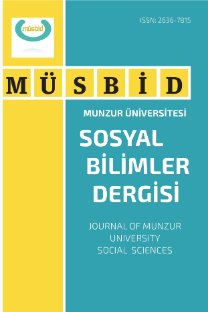MÖ. II. YÜZYILDA DOĞU'DAKİ SÜPER GÜÇ: PARTHLAR
Yakın Doğu, Parthlar, Mithridates, Mezopotamya, Syria
___
- Altıngök, A. (2015). İslam Öncesi İran’da Devlet ve Ekonomi – Sâsânî Dönemi – (M.S. 226-652), İstanbul.
- Appianus, (1912-1913). Appian’s Roman History, translated by H. White, Cambridge.
- Bivar, A. D. H. (2006). “The Political History of Iran Under The Arsacids”, CHI, ed. Ehsan Yarshater, C. 3, p. 1, 4.b, Cambridge.
- Brosius, M. (2006). The Persians: An Introduction, Abingdon.
- Bryce, T. ve Birkett-Rees, J. (2006). Atlas of the Ancient Near East (From Prehistoric Times to the Roman Imperial Period), London & New York.
- Clinton, H. F. (2010). Fasti Romani (The Civil and Literary Chronology of Rome and Constantinople, from the Death of Augustus to the Death of Justin II), vol. II, Cambridge & New York.
- Curtis, V. S. (2007). “The Iranian Revival in the Parthian Period”, The Idea of Iran, C.2, ed. Vesta Sarkhosh Curtis & Sarah Stewart, London, ss. 7-25.
- Dabrowa, E. (2012). “The Arsacid Empire”, The Oxford Handbook of Iranian History, ed. Touraj Daryaee, Oxford, ss. 164-186.
- Debevoise, N.C. (1938). A Political History of Parthia, Chicago.
- Diodorus Siculus (1957). Library of History, vol. XI. translated by C. H. Oldfather, Cambridge.
- Errington, R.M. (2017). Hellenistik Dünya Tarihi (MÖ 323-30), çev. Gülşah Günata, İstanbul.
- Fisher, G. (2020). Rome, Persia and Arabia Shaping the Middle East From Pompey to Muhammad, London and New York.
- Frye, (1984). The History of Ancient Iran, München.
- Garthwaite, G.R. (2005). The Persians (Peoples of Asia), Oxford.
- Gilmore, J. E. (1892). “Babylonia Under the Greek and the Parthians”, The English Historical Review, vol.7, no. 25, ss. 1-10.
- Gregoratti, L. (2017). “The Arsacid Empire”, King of Seven Climes: A History of The Ancient Iranian World (3000 BCE – 651 CE), ed. Touraj Daryaee, California, ss. 125-153.
- Herodotos, (1991). Herodot Tarihi, çev. M. Ökmen-A. Erhat, İstanbul.
- Iustinus, (1853). Epitome of the Philippic History of Pompeius Trogus, translated by the Rev. John Selby Watson, London.
- Karatay, O. (2019). İran ile Turan, 3.b., İstanbul.
- Katouzian, H. (2009). The Persians: Ancient, Medieval and Modern Iran, New Haven and New York.
- Kent, R. G. (1950). Old Persian. Grammar Texts Lexicon, American Oriental Society, New Haven-Connecticut.
- Khurt, A. (2017). Eskiçağ’da Yakındoğu, C.2, 4.b, çev. Dilek Şendil, İstanbul.
- Kurtuluş, R. (1993). “Cürcan”, Türkiye Diyanet Vakfı İslam Ansiklopedisi (DİA), C.8, İstanbul, ss. 131-132.
- Luckenbill, D.D. (1927). Ancient Records of Assyria and Babylonia, vol. II, Chigaco.
- Mehl, A. (2004). “Demetrius”, Brill’s New Pauly, ed. Christine F. Salazar vd., C.4, Leiden-Boston, ss. 247-248.
- Monerie, J. (2019). “Invading Mesopotamia from Alexander the Great to Antiochus VII”, Literary Change in Mesopotamia and Beyond and Routes and Travellers between East and West, vol.2, ed. Rocio Da Riva vd. Münster, ss. 155-185.
- Olbrycht, M. J. (2003). “Parthia and Nomads of Central Asia. Elements of Steppe Origin in the Social and Military Developments of Arsacid Iran”, Orientwissenchaftliche Hefte, ss. 69-109.
- Olbrycht, M. J. (2010). “Mithridates I of Parthia and His Conquest”, Hortus Historiae Studies in Honour of Prefessır Jozef Wolski on the 100th Anniversary of His Birthday, ed. Edward Dabrowa vd., Krakow, ss. 229-245.
- Olshausen, E. (2004). “Dahae”, Brill’s New Pauly, ed. Christine F. Salazar vd., Leiden-Boston, s.39.
- Pourshariati, P. (2008). Decline and Fall of The Sasanian Empire, London.
- Schottky, M. (2003). “Arsaces”, Brill’s New Pauly, ed. Christine F. Salazar vd., C.2, Leiden-Boston, s. 31.
- Schottky, M. (2006). “Mithridates”, Brill’s New Pauly, ed. Christine F. Salazar vd., C.9, Leiden-Boston, ss. 83-85.
- Shayegan, M. R. (2003). “On Demetrius II Nicator’s Arsacid Captivity and Second Rule”, Bulletin of the Asia Institute, vol. 17, ss. 83-103.
- Sherwin-White A.N ve Khurt A. (1993). From Samarkhand to Sardis: A New Approach to the Seleucid Empire, Berkeley-Los Angeles.
- Strabon, (1917-1932). Geography, translated by H.L. Jones, Cambridge.
- Strootman, R. (2011-2012). “The Seleukid Empire between Orientalism and Hellenocentrism: Writing the history of Iran in the Third and Second Centuries BCE”, The International Journal of Ancient Iranian Studies, ss. 17-35.
- Strootman, R. (2017). “Imperial Persianism: Seleukids, Arsakids, Fratarakā”, Persianism in Antiquity, ed. R. Strootman and M. J. Versluys, Stuttgart, ss.177-200 . Strootman, R. (2018). “The Coming of the Parthians: Crisis and Resilience in Seleukid Iran in the reign of Seleukos II”, The Seleukid Empire 281–222 BC: War Within the Family, ed. K. Erickson, Swansea, ss. 128-150.
- Tosun, S. P. (2020). Antik Çağ’da Doğu-Batı Mücadelesi Kapsamında Roma-Part İlişkileri, Yayınlanmamış Yüksek Lisans Tezi, Uludağ Üniversitesi, Bursa.
- Wisehöfer, J. (2007). “Parthia”, Brill’s New Pauly, ed. Christine F. Salazar vd., C.10, Leiden-Boston, ss. 572.
- Wiesehöfer, J. (2002). Antik Pers Tarihi, çev. Mehmet Ali İnci, İstanbul.
- Yayın Aralığı: Yılda 2 Sayı
- Başlangıç: 2012
- Yayıncı: Munzur Üniversitesi
BİR KENTİN HAFIZA MEKÂNI; DOĞUBAYAZIT AHMED-İ HANİ KENT MÜZESİ
İMPARATOR DOMİTİANUS: KİŞİLİĞİ VE SUİKASTI
MÖ. II. YÜZYILDA DOĞU'DAKİ SÜPER GÜÇ: PARTHLAR
MENZİL KÜLLİYELERİNDE YER ALAN SIBYAN MEKTEPLERİ
MÖ. II. YÜZYILDA DOĞU'DAKİ SÜPER GÜÇ: PARTHLAR
TUNCELİ ARKEOLOJİ VE ETNOGRAFYA MÜZESİ BAĞLAMINDA SOMUT OLMAYAN KÜLTÜREL MİRASIN DESTEKLENMESİ
PATOLOJİK İNTERNET KULLANIMI VE BAĞIMLILIĞA DÖNÜŞÜMÜ
NARSİZM VE LİDERLİK TOKSİK LİDERLİK ÖRNEKLERİ: HİTLER & STALİN
NARSİZM VE LİDERLİK TOKSİK LİDERLİK ÖRNEKLERİ: HİTLER & STALİN
MÜZİĞİN ETKİSİNDEKİ BEYİN: BİR SAPLANTININ BİLİMSEL İNCELEMESİ
